
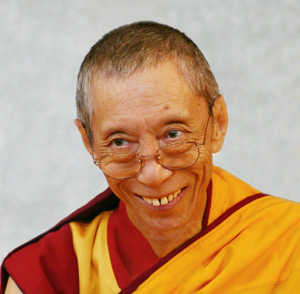 Venerable Geshe Kelsang Gyatso is a fully accomplished meditation master and internationally renowned teacher of Buddhism. Geshe-la, as he is affectionately called by his students, is primarily responsible for the worldwide revival of Kadampa Buddhism in our time.
Venerable Geshe Kelsang Gyatso is a fully accomplished meditation master and internationally renowned teacher of Buddhism. Geshe-la, as he is affectionately called by his students, is primarily responsible for the worldwide revival of Kadampa Buddhism in our time.
Geshe Kelsang Gyatso was born on Dharmachakra Day (the 4th day of the 6th month of the Tibetan lunar calendar) 1931 in Yangcho Tang, eastern Tibet. His lay name was Lobsang Chuponpa. His mother made great sacrifices to enable her son to attend the Ngamring Jampa Ling Monastery because he showed interest and aptitude from an early age. He joined the monastery when he was 8 years old. From then on, he studied extensively in the great monastic universities of Tibet and earned the title ‘Geshe’ (which literally means ‘spiritual friend’).
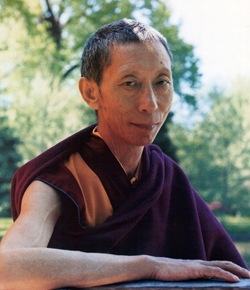
Later Geshe Kelsang studied for 15 years at Sera Monastery near Lhasa, one of the great Gelug monastic universities of Tibet. His ordination name “Kelsang Gyatso” means “Ocean of Good Fortune”. At Sera Je, he successfully completed the full Geshe studies of five large philosophical texts. After passing two examinations at Tashilhunpo Monastery in Shigatse, he received his Geshe degree. He was a member of the Tsangpa Khangtsen, one of the fifteen houses at Sera Je monastery. Contemporaries at Sera Je included Geshe Lhundub Sopa, Geshe Rabten, and Lama Thubten Yeshe.
Geshe Kelsang Gyatso’s “Spiritual Father” was the great Gelugpa Master Kyabje Trijang Dorjechang (1900-1981AD), who was at one time the Throne Holder (or Ganden Tripa) of Je Tsongkhapa’s tradition. He describes his root Guru as “a vast reservoir from which all Gelugpa practitioners of the present day received “waters of blessings and instructions.” Trijang Rinpoche was also the Junior Tutor and Spiritual Guide of the 14th Dalai Lama for fifty years. Geshe Kelsang has repeatedly talked about his complete indebtedness to and reliance upon his Spiritual Guide, describing him as more important than his life.
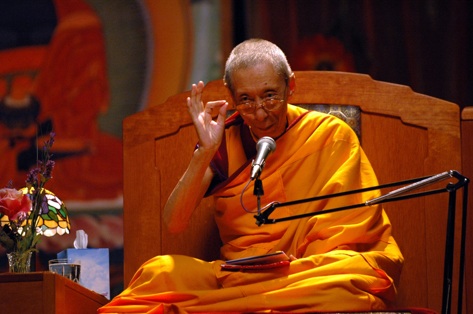
After the exodus from Tibet in 1959, Geshe Kelsang escaped to India through Nepal and stayed at the initial location of his monastery, in Buxar. All he took with him were two Buddhist scriptures – Shantideva’s Guide to the Bodhisattva’s Way of Life and a text by Je Tsongkhapa. Later, after Prime Minister Nehru donated large tracts of land in South India to the community in exile, the monastery moved south. At this time, Geshe Kelsang left the monastery at Buxar for Mussoorie (a hill station in the Indian state of Uttaranchal) where he taught and engaged in intensive meditation retreat for 18 years.
In 1977 he accepted an invitation from Lama Yeshe to be the Resident Teacher at Manjushri Kadampa Meditation Centre in England, where he has lived and taught ever since, giving teachings and guidance to an ever-growing group of disciples.
 David Kay, in his book, Tibetan and Zen Buddhism in Britain: Transplantation, Development and Adaptation notes that this invitation was also under the advice of the Dalai Lama. The invitation was extended by Trijang Rinpoche, the root Guru of Geshe Kelsang. He arrived in August 1977 and gave his first teaching on Lamrim on September 10. Geshe Kelsang later recounted that Kyabje Trijang Rinpoche asked him to go to England, teach Shantideva’s Guide to the Bodhisattva’s Way of Life, Chandrakirti’s Guide to the Middle Way and Lamrim, and then “check whether there was any meaning in his continuing to stay.”
David Kay, in his book, Tibetan and Zen Buddhism in Britain: Transplantation, Development and Adaptation notes that this invitation was also under the advice of the Dalai Lama. The invitation was extended by Trijang Rinpoche, the root Guru of Geshe Kelsang. He arrived in August 1977 and gave his first teaching on Lamrim on September 10. Geshe Kelsang later recounted that Kyabje Trijang Rinpoche asked him to go to England, teach Shantideva’s Guide to the Bodhisattva’s Way of Life, Chandrakirti’s Guide to the Middle Way and Lamrim, and then “check whether there was any meaning in his continuing to stay.”
In Geshe Kelsang’s own words: “When I was in India I received an invitation from Manjushri Institute in England through Lama Yeshe, who was my very close friend in Tibet. He and I were from the same monastery in Tibet and we had the same Teacher. He wrote to me and requested me please to go to England and give Dharma teachings. I received this invitation but I didn’t answer for two months. At that time it was difficult for me to say yes due to certain commitments to local Tibetan people, and also I thought how could I teach as I could not speak English? I had no confidence. Lama Yeshe was very clever; he went to visit my root Guru Kyabje Trijang Rinpoche, and requested him to ask me to go to England to teach Dharma. He knew if my root Guru asked me, then I would agree to go.”
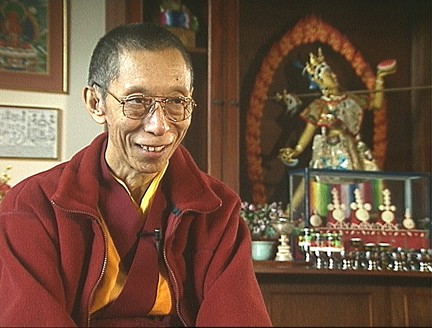
In 1987, Geshe Kelsang entered a three-year retreat at Tharpaland Retreat Centre in Dumfries, Scotland. During his retreat, he wrote five books and established the foundations of the NKT-IKBU. After completing his retreat in the spring of 1991, Geshe Kelsang announced the creation of the New Kadampa Tradition- International Kadampa Buddhist Union (NKT-IKBU), an event which was celebrated by his students in the NKT-IKBU magazine Full Moon as “a wonderful development in the history of the Buddhadharma.” Since that time, the NKT-IKBU has grown to comprise over 1100 Centres and groups throughout 40 countries.
The NKT-IKBU is a Mahayana form of Buddhism, which has been developed from the Gelug school of Tibetan Buddhism. The NKT-IKBU states that it follows the tradition of Kadampa Buddhism derived from the Buddhist meditators and scholars Atisha (AD 982-1054) and Je Tsongkhapa (1357-1419 AD), as taught by Geshe Kelsang Gyatso. The New Kadampa Tradition “offers standard Gelugpa teachings based on Geshe Kelsang’s books, which present a systematic path to enlightenment.
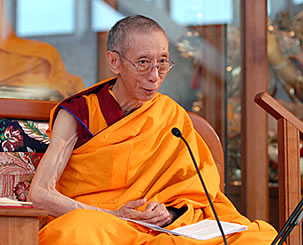
At the heart of the NKT-IKBU are its three study programs: the General Program, the Foundation Program, and the Teacher Training Program. In these programs people can study Geshe Kelsang’s books with authorized NKT-IKBU Dharma teachers.
According to the NKT-IKBU, it “seeks not to offer a westernized form of Buddhism, but rather to make traditional Gelugpa Buddhism accessible to westerners.”
To achieve this, Geshe Kelsang taught himself English and wrote 22 books that aim to provide Western Dharma practitioners with essential Buddhist texts. His first book published in 1980 was a commentary to Shantideva’s Guide to the Bodhisattva’s Way of Life called Meaningful to Behold. This was followed by Clear Light of Bliss in 1982. His books were first published by Wisdom Publications. In 1985, Tharpa Publications was founded, which since has been the exclusive publisher of his works worldwide. He has gone on to publish a series of remarkable books on Buddhism and meditation, from basic introductory books to advanced philosophical texts and meditation manuals. Over a million copies of Geshe Kelsang’s books have been sold.
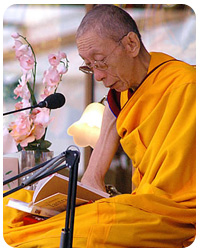
The books are also highly thought of within the Tibetan establishment. Three of his published works contained forewords by previous Ganden Tripas and the Dalai Lama. The Dalai Lama contributed a foreword to Buddhism in the Tibetan Tradition, while Trijang Rinpoche and Ling Rinpoche (who each also held the position of Ganden Tripa) also provided forewords for his books Meaningful to Behold (which was dedicated to the long life of the Dalai Lama) and Clear Light of Bliss (which was dedicated to the late Trijang Rinpoche), respectively. Kyabje Ling Rinpoche refers to Geshe Kelsang as “this most precious Spiritual Guide,” while Kyabje Trijang Rinpoche refers to him as “The excellent expounder, the great Spiritual Master Kelsang Gyatso.”
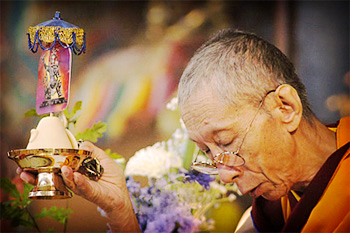
Each year, Geshe-la gives teachings and empowerments at the International Kadampa Festivals, which are attended by thousands of people from all over the world.
In his teachings, Geshe Kelsang emphasizes the importance of meditation and how to apply it in daily life, the need to be truly happy, and how to cultivate a good heart to help others — and he demonstrates these qualities perfectly in his own life.
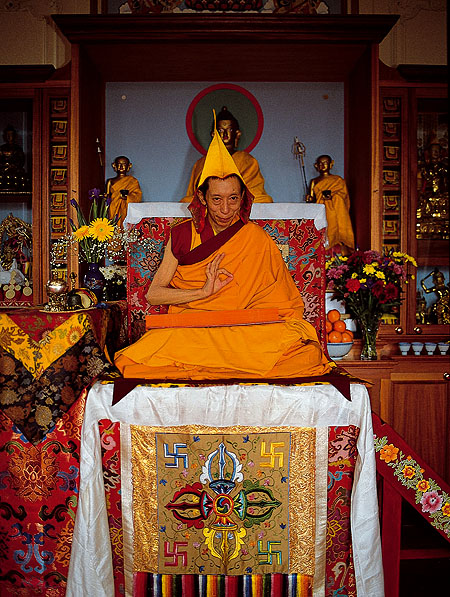
This remarkable Teacher inspires so many people from so many different countries because he teaches from example. He is a humble Buddhist monk dedicated to helping people throughout the world find true happiness in their hearts.
Source:
Official site of NKT
http://kadampa.org/en/buddhism/venerable-geshe-kelsang-gyatso/
Wikipedia
http://en.wikipedia.org/wiki/Kelsang_Gyatso
http://en.wikipedia.org/wiki/NKT-IKBU










































 English
English Indonesia
Indonesia Tibetan
Tibetan
Robert
March 1, 2011
Dear Geshe-la,
Your book, the Joyful Path of Good Fortune has truly impacted my life and offered many answers to complex spiritual questions I had struggled with for many years. With your help, I am better prepared to help those on the path who seek my help during their times of need.
Thank You for your compassion and wisdom,
Robert
Mike Hume
May 14, 2011
When I became interested in Buddhism I tracked down whatever books I could find on the subject. I found almost everything I read to be like calming medicine for my troubled mind, but I struggled to really understand how the teachings of Buddha could really be applied in my daily life, and many of the teachings were impossible to understand. When I discovered my first book by Geshe Kelsang (Heart of Wisdom), it was like I had found something written in my own language. It was so clear and practical. I have read all of geshe-la’s books and love then all. Thank you Geshe-la. I pray I will come under your care in life after life until I become an enlightened being.
Genevieve Mancini
September 6, 2014
Dear Venerable Geshe-la,
I have searched for a spiritual path for most of my life. My life had meaning once I found Kadama Dharma.
I met Kadam Dharma in 2001 when I attended Gen Togen’s GP class and I have been part of Dipamkara ever since.
Such good fortune to have met you. Please send your blessings,
With love, Genevieve Mancini
Eve
January 15, 2015
From the lineage of Venerable Tsongkhapa we are blessed with Geshela. Thank you for turning the great wheel.
Joe Stains
January 1, 2016
The NKT; a creepy, money-grabbing cult